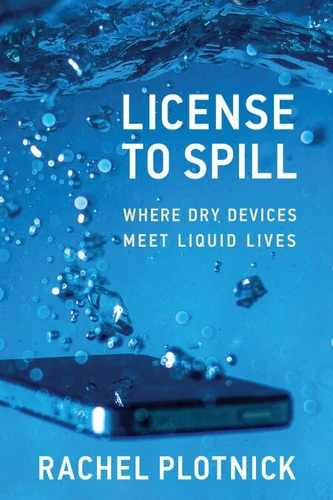License to Spill. Where Dry Devices Meet Liquid Lives
Par :Formats :
Disponible dans votre compte client Decitre ou Furet du Nord dès validation de votre commande. Le format ePub protégé est :
- Compatible avec une lecture sur My Vivlio (smartphone, tablette, ordinateur)
- Compatible avec une lecture sur liseuses Vivlio
- Pour les liseuses autres que Vivlio, vous devez utiliser le logiciel Adobe Digital Edition. Non compatible avec la lecture sur les liseuses Kindle, Remarkable et Sony
- Non compatible avec un achat hors France métropolitaine
 , qui est-ce ?
, qui est-ce ?Notre partenaire de plateforme de lecture numérique où vous retrouverez l'ensemble de vos ebooks gratuitement
Pour en savoir plus sur nos ebooks, consultez notre aide en ligne ici
- Nombre de pages306
- FormatePub
- ISBN978-0-262-38192-5
- EAN9780262381925
- Date de parution29/04/2025
- Protection num.Adobe DRM
- Taille29 Mo
- Infos supplémentairesepub
- ÉditeurThe MIT Press
Résumé
How everyday wetness-from finger smudges, sweat, and spilled drinks to showering and swimming-collides with consumers' media devices designed to stay dry. License to Spill investigates the everyday moments, activities, and spaces where media technologies and liquids collide-from disastrous spilled drinks that corrode laptops and drops in the toilet that drown smartphones to the greasy finger smudges and sweat droplets that sully screens and glitch smartwatches.
Putting historical and present-day case studies in conversation, Rachel Plotnick considers how people's experiences with media devices inevitably encounter wetness and yet consumers-not the companies who make the devices-take the blame when leaks, spillages, and overflows occur. Along with thinking about preventive measures and device caretaking, License to Spill examines how water-resistant and waterproofed technologies, through their design and marketing, imagine the brawniest and hardiest of users meant to "punish" and "abuse" their "tough" devices, granting them unfettered permission to get wet.
Examining a long history of "torture testing" and hyperbolic claims of imperviousness, the book demonstrates how protective designs relate to broader cultural ideas about media use as sporty, luxurious, excessive, or messy. This context is especially relevant given that the market for water-resistant bags, cases, coatings, and seals has flourished over the past decade, with new rhetoric about wetness as "natural" and digital technologies as ever-present.
The book pushes us to attend to both the ideals and problems that arise when designing "resilient" devices, ranging from the "right to repair" movement and lawsuits over ingress protection (IP) ratings to obsolescence culture and work-from-home activities in the wake of the COVID-19 pandemic.
Putting historical and present-day case studies in conversation, Rachel Plotnick considers how people's experiences with media devices inevitably encounter wetness and yet consumers-not the companies who make the devices-take the blame when leaks, spillages, and overflows occur. Along with thinking about preventive measures and device caretaking, License to Spill examines how water-resistant and waterproofed technologies, through their design and marketing, imagine the brawniest and hardiest of users meant to "punish" and "abuse" their "tough" devices, granting them unfettered permission to get wet.
Examining a long history of "torture testing" and hyperbolic claims of imperviousness, the book demonstrates how protective designs relate to broader cultural ideas about media use as sporty, luxurious, excessive, or messy. This context is especially relevant given that the market for water-resistant bags, cases, coatings, and seals has flourished over the past decade, with new rhetoric about wetness as "natural" and digital technologies as ever-present.
The book pushes us to attend to both the ideals and problems that arise when designing "resilient" devices, ranging from the "right to repair" movement and lawsuits over ingress protection (IP) ratings to obsolescence culture and work-from-home activities in the wake of the COVID-19 pandemic.
How everyday wetness-from finger smudges, sweat, and spilled drinks to showering and swimming-collides with consumers' media devices designed to stay dry. License to Spill investigates the everyday moments, activities, and spaces where media technologies and liquids collide-from disastrous spilled drinks that corrode laptops and drops in the toilet that drown smartphones to the greasy finger smudges and sweat droplets that sully screens and glitch smartwatches.
Putting historical and present-day case studies in conversation, Rachel Plotnick considers how people's experiences with media devices inevitably encounter wetness and yet consumers-not the companies who make the devices-take the blame when leaks, spillages, and overflows occur. Along with thinking about preventive measures and device caretaking, License to Spill examines how water-resistant and waterproofed technologies, through their design and marketing, imagine the brawniest and hardiest of users meant to "punish" and "abuse" their "tough" devices, granting them unfettered permission to get wet.
Examining a long history of "torture testing" and hyperbolic claims of imperviousness, the book demonstrates how protective designs relate to broader cultural ideas about media use as sporty, luxurious, excessive, or messy. This context is especially relevant given that the market for water-resistant bags, cases, coatings, and seals has flourished over the past decade, with new rhetoric about wetness as "natural" and digital technologies as ever-present.
The book pushes us to attend to both the ideals and problems that arise when designing "resilient" devices, ranging from the "right to repair" movement and lawsuits over ingress protection (IP) ratings to obsolescence culture and work-from-home activities in the wake of the COVID-19 pandemic.
Putting historical and present-day case studies in conversation, Rachel Plotnick considers how people's experiences with media devices inevitably encounter wetness and yet consumers-not the companies who make the devices-take the blame when leaks, spillages, and overflows occur. Along with thinking about preventive measures and device caretaking, License to Spill examines how water-resistant and waterproofed technologies, through their design and marketing, imagine the brawniest and hardiest of users meant to "punish" and "abuse" their "tough" devices, granting them unfettered permission to get wet.
Examining a long history of "torture testing" and hyperbolic claims of imperviousness, the book demonstrates how protective designs relate to broader cultural ideas about media use as sporty, luxurious, excessive, or messy. This context is especially relevant given that the market for water-resistant bags, cases, coatings, and seals has flourished over the past decade, with new rhetoric about wetness as "natural" and digital technologies as ever-present.
The book pushes us to attend to both the ideals and problems that arise when designing "resilient" devices, ranging from the "right to repair" movement and lawsuits over ingress protection (IP) ratings to obsolescence culture and work-from-home activities in the wake of the COVID-19 pandemic.




